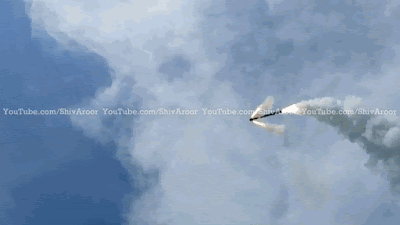Interesting story of BrahMos targets, you can actually tell which seeker the missile is actually using just by looking at its target. BrahMos has been tested with several seekers:
1. Russian run-of-the-mill RF scanning anti-shipping seeker
2. Russian RF imaging seeker with discrimination capability (for enhanced land-attack capability).
3. Indian LRDE-ECIL RF scanning seeker
4. Indian LRDE-ECIL RF Imaging seeker (yet to be tested)
The original scanning seeker wasn't really designed for land attack purposes and that's why corner reflectors were used in early ground-attack testings. The corner-reflectors make it much easier for a scanning seeker to find its target and the result is:
 |
This is how a corner reflector looks like in radar images, all nice and bright (lotsa echo) helps the seeker pick the target out through all the clutter. The original seeker wasn't designed for land targets. It's quite easy for a scanning seeker to pick out a hunk of metal sitting all nice and alone in the water but there is no such luxury on the land. There is a lot of reflectors and it only gets worse if the target is located in an urban area. This problem was solved by adding imaging capability in the Block-2 variant of BrahMos and this is where BrahMos gets what is unique about it and how it differs from its sister missiles (Yakhont and Oniks): Target Discrimination Capability.
 |
| A SAR image with corner reflectors |
The Block-2 variant of BrahMos has an RF imaging seeker which is a massive improvement over the baseline variant, Block-1. This particular capability was tested for the first time in 2009 when the target was a factory located in a simulated urban environment i.e. a lot of reflectors were placed around the target (that's a lot of clutter) in order to confuse the missile. However, the missile successfully picked out the target and homed-in accurately. Only one regiment worth of Block-1 was inducted in the army, all subsequent orders were of Block-2 and Block-3.
The Block-3 variant has advanced guidance (improved discrimination capability, multi-constellation updates, operation in GPS denial modes) and is capable of executing complex maneuvers- it's the most sophisticated ground attack missile currently in the Indian military or at least until the ITCM becomes operational. It's capable of accurately hitting deep-buried targets. A 2.5-ton missile, with a 200kg penetration warhead (for ground attack), dives almost vertically at ~Mach 3. The result is what they call aggressive landscaping.
 |
| BrahMos Block-3 vertical dive test |
 |
| That's a lot of oof |



Comments
Post a Comment